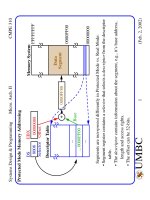Thiết kế và lập trình hệ thống - Chương 3
Bạn đang xem bản rút gọn của tài liệu. Xem và tải ngay bản đầy đủ của tài liệu tại đây (107.1 KB, 5 trang )
Systems Design & Programming Micro. Arch. III CMPE 310
1 (Feb 2, 2002)
UMBC
U M B C
U
N
I
V
E
R
S
I
T
Y
O
F
M
A
R
Y
L
A
N
D
B
A
L
T
I
M
O
R
E
C
O
U
N
T
Y
1
9
6
6
Memory Addressing
Memory Paging:
Available in the 80386 and up.
Allows a linear address (virtual address) of a program to be located in any por-
tion of physical memory.
The paging unit is controlled by the microprocessors control registers:
31
12
11 0
VME
PVI
TSD
DE
PSE
MCE
PWT
PCD
Page Directory Base Address
Most recent Page Faulting Linear Address
Reserved
PE
MP
EM
TS
ET
NE
WP
AM
NW
CD
PG
CR0
CR1
CR2
CR3
CR4
(Pentium and up)
Systems Design & Programming Micro. Arch. III CMPE 310
2 (Feb 2, 2002)
UMBC
U M B C
U
N
I
V
E
R
S
I
T
Y
O
F
M
A
R
Y
L
A
N
D
B
A
L
T
I
M
O
R
E
C
O
U
N
T
Y
1
9
6
6
Memory Addressing
Memory Paging:
The paging system operates in both real and protected mode.
It is enabled by setting the PG bit to 1 (left most bit in CR0).
(If set to 0, linear addresses are physical addresses).
CR3 contains the page directory “physical” base address.
The value in this register is one of the few “physical” addresses you will ever
refer to in a running system.
The page directory can reside at any 4K boundary since the low order 12
bits of the address are set to zero.
The page directory contains 1024 directory entries of 4 bytes each.
Each page directory entry addresses a page table that contains up to 1024
entries.
Systems Design & Programming Micro. Arch. III CMPE 310
3 (Feb 2, 2002)
UMBC
U M B C
U
N
I
V
E
R
S
I
T
Y
O
F
M
A
R
Y
L
A
N
D
B
A
L
T
I
M
O
R
E
C
O
U
N
T
Y
1
9
6
6
Memory Addressing
Memory Paging:
The virtual address is broken into three pieces:
• Directory: Each page directory addresses a 4MB section of main mem.
• Page Table: Each page table entry addresses a 4KB section of main mem.
• Offset: Specifies the byte in the page.
11
12
212231
Directory
Page Table
Offset
31 12
Physical Address
0
Linear or Virtual Address
Page Directory or Page Table Entry
P
W
U
PWT
PCD
A
D
Present
Writable
User defined
Write through
Cache disable
Dirty (0 in page dir)
Accessed
Systems Design & Programming Micro. Arch. III CMPE 310
4 (Feb 2, 2002)
UMBC
U M B C
U
N
I
V
E
R
S
I
T
Y
O
F
M
A
R
Y
L
A
N
D
B
A
L
T
I
M
O
R
E
C
O
U
N
T
Y
1
9
6
6
Memory Addressing
Memory Paging:
11
12
212231
[00]0C
[00]10 0x08A
0
Virtual Address:
CR3
00010 +
+
0x00010030
0x05001
0x05000000
0x05001000
0x05001040
0x00020000
0x00021000
0x00030000
0x00030
+
0x0003008A
[binary]hex
0x0301008A
=0x030
*4
*4
=0x040
Systems Design & Programming Micro. Arch. III CMPE 310
5 (Feb 2, 2002)
UMBC
U M B C
U
N
I
V
E
R
S
I
T
Y
O
F
M
A
R
Y
L
A
N
D
B
A
L
T
I
M
O
R
E
C
O
U
N
T
Y
1
9
6
6
Memory Addressing
Memory Paging:
The page directory is 4K bytes.
Each page table is 4K bytes, and there are 1024 of them.
If all 4GB of memory is paged, the overhead is 4MB!
The current scheme requires three accesses to memory:
One to the directory, one to the appropriate page table and (finally) one to
the desired data or code item. Ouch!
A Translation Look-aside Buffer (TLB) is used to cache page directory
and page table entries to reduce the number of memory references.
Plus the data cache is used to hold recently accessed memory blocks.
System performance would be extremely bad without these features.
Much more on this in OS (CMSC 421).
Paging and Segmentation:
These two addresses translation mechanism are typically combined.
We’ll look at this in later chapters.









